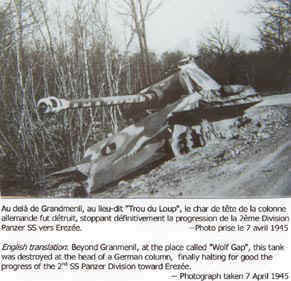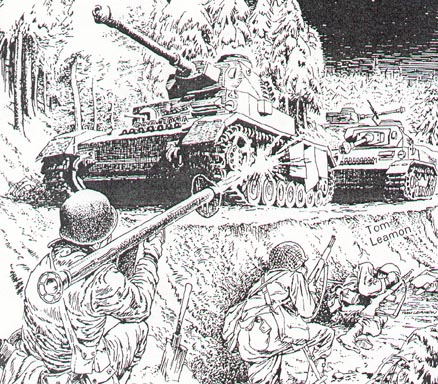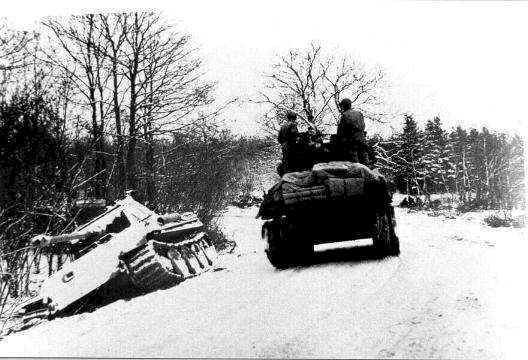|
THE NAMING OF A HERO |
|
|
Time: 0300, 25 December, 1944. Place: Belgium, the Ardennes, the woods southwest of the strategic towns of Grandmenil / Manhay. Situation: A column of German "Panther" tanks, led by a captured "Sherman", rumbles down the road toward the west and Liege. The "Panthers" have split the defensive line of foxholes held by the 3rd Battalion of the 289th Regiment and are blasting the infantrymen on both sides of the road. The tanks have crushed an American "Jeep" and the soldiers, under fire for the first time, crouch in their holes, confused. |
|
|
One man, however, a Corporal, shoulders and loads his bazooka, and with one shot halts the lead tank. In the next instant a German shell blows the man away - but the German column is stopped. Trapped on a road |
|
|
|
behind a dead tank, a high cliff and a steep ravine, the German column retreats - and this thrust of the German drive west ended. Forty - six years later, in Sacramento, Al Roxburgh (Cannon - 289), was reading the official Army account of that Ardennes encounter. The noted historian, Dr. Hugh M. Cole, in his 700 page volume, The Ardennes: The Battle of the Bulge, wrote a dramatic account of the battle, but was unable to identify the soldier who gave his life halting the Christmas drive of the Panzers. Roxburgh's sense of justice was (agitated). "With survivors of that battle still about," Roxburgh reasoned, "Why shouldn't we be able to give that man a name - and the credit and honor due him?" Roxburgh started inquiries. At the 44th Reunion of the 75th Infantry Division in St. Louis, July 1990, Roxburgh talked with K - Company 289th Regiment veterans. Someone produced a history of King Company, with names and photos of each soldier in that unit. Roxburgh found particular help from Dave Fennessey of Quincy, Massachusetts. Dave himself had been part of the Christmas Eve action, and recalled the event in vivid detail - including the name of the nameless bazookaman whose death made history: he was Cpl. Richard F. Wiegand. To date, no record of Wiegand's place of origin is known. Having successfully identified Wiegand, Al Roxburgh forwarded the results of his research to the U.S. Army Center of Military History in Washington. While Wiegand will remain "nameless" in Cole's history of the battle, the identity of Cpl. Wiegand has been placed in the file of the 289th Infantry Regiment, in our nation's National Archives, where it will be available for future historians. Written by Tom Leamon (A - 289) from material provided by Alfred S. Roxburgh and Dave Fennessy: June 1991. he Bulgebuster Newsletter Vol. 47 No. 5 Aug. 1991 |
|
I received the following email from Raymond Smith. It highlights and explains a few details of this incident. |
|
|
...While perusing your website today I
opened the subject portion of it
and was gratified to see that you have published the story of Cpl. Richard
F. Wiegand, K-289 as reported by Tom Leamon (A-289) in the August 1991 75th
Div. "BulgeBuster".
Some bits of new information that have come to light
over the past ten years: Wiegand was buried at the Henri Chapelle
American
Cemetery in Belgium, grave H 2 52. Several of us reverently visited
his
gravesite in August 1994. Cemetery records give his place of enlistment as |
|
|
|
|
|
Grave site of Richard F. Wiegand, 289th infantry Regiment, located at Henri Chapelle Cemetery, Belgium. |
|
|
Cpl. Richard F. Wiegand Died 0300 hrs, 25 December 1944 near Grandmenil, Belgium U.S. residence: Maryland. A member of K Company, 289th Reg., 75th Inf. Div. Acknowledgements: The following narrative has been compiled from several sources in an effort to obtain from them a consensual and accurate account of the described incident, including the name of its hero. Sources that have been quoted and paraphrased include A Time for Trumpets, Charles B. McDonald, pp. 22-38, 557-558, Wm. Morrow & Co., Inc., 1985; 75th Bulgebusters Vol. 47 No. 5, p. 7, August 1991; Ibid Vol. 47, No. 6, October 1991, pp. 4,6. The inspired effort to identify Cpl. Wiegand as the previously anonymous hero of the incident was led by Alfred S. Roxburgh, CN-289. Wiegand's identification was made in July 1990 by one of his surviving K-289 comrades, Dave Fennessey. Richard now rests in location H-2-52 of the Henri-Chapelle American Military Cemetery northeast of Liege, Belgium. His next-of-kin remain unknown. Time: 0300 hours 25 December 1944 Place: An Allied roadblock in the Ardennes, on the Erezée-Grandmenil road at "Trou du Loup" (Wolf Gap), 1.7 miles west of Grandmenil, Belgium The roadblock was on the road between Grandmenil and Erezée, just west of Grandmenil. It had been set up, probably several hours earlier on Christmas Eve, by members of K Company, 289th Infantry Regiment under orders from General Hickey of the 3rd Armored Division to which the 289 CT had been attached. Both the main highway and a secondary road leading northwest to the Ourthe River were to be blocked by the 289th Infantry's 3rd Bn. It was to be their first combat assignment, a chaotic baptism of fire. Meanwhile, lead elements of General Heinz Lammerding's 2nd SS Panzer Division had reached Manhay, a half mile or so east of Grandmenil and on the same highway. Lammerding's immediate objective was to take the villages of Grandmenil and Erezée, from which roads led northwest to a crossing of the Ourthe River at Durbruy, six miles downstream from the town of Hotton. A platoon of self-propelled tank destroyers from the American 3rd Armored Division's Task Force Kane, had been in Grandmenil but lacked infantry support. Faced with a force of SS-Panzergrenadiers closing on them as darkness fell, the TDs retired towards Erezée. Thus, only the 289th's roadblock stood between Lammerding and his main objective: An Ourthe River crossing. One account of what happened next says that the 2nd SS Panzer's probe west from Grandmenil was led by a captured, German-manned Sherman decoy, a ruse they employed to deceive the American troops. The presence of such a decoy explains how the head of the tank column was able to penetrate the road block so deeply as to run over and destroy American vehicles and trailers before they were discovered. Whether or not a Sherman decoy was actually used, the consensus seems to be that the rest of the column consisted of eight Panthers, the German army's main battle tank. They proceeded to wreak havoc amongst the troops of the 289th's 3rd Bn deployed in the ditches on either side of the road and in foxholes adjacent to it...Men who were already beset by fatigue, bitter cold, and deadly tree bursts from the "friendly fire" of their own artillery, as recalled by Jim Pease, K-289. Dino Argentini, 3rd Bn HQ-289, recalls that the enemy tank column was actually in the process of making its way through a marching column of the 3rd Bn also moving along the road (in the opposite direction), when their "cover" was blown by a German tanker yelling something in German. Dino relates that once recognized as the enemy, the tanks became targets for "many, many" bazooka rockets aimed at them by the men of the 3rd Bn. But none exploded, because in their haste and inexperience, they had neglected to arm their rockets by pulling the safety pins. However, one soldier from K Company, Richard F. Wiegand, remembered to arm his. Dino remembers that the brave corporal "got behind the lead Panther tank and put a rocket right into one of the two tool boxes hanging on the stern of the tank. The rocket went right into the engine disabling it." Dave Fennessey, K-289, recalls that in the next instant, Wiegand was "blown away" by a German shell. Despite efforts of the next tank in line to clear the way by pushing the disabled machine aside and down the embankment, it was unable to do so and the road remained blocked. The German tanks had no choice but to spin in their tracks and head back to Grandmenil, flattening jeeps and trailers as they went. Had they been able to get past, they would have faced little or no opposition and almost certainly would have led the rest of the 2nd SS Panzer Division across the Ourthe, thus substantially increasing the likelihood of achieving at least the "Small Solution" (von Rundstedt's "Small Slam"): the capture of Liége and encirclement of a million Allied troops.
|
|
|
"Trou du Loup" (Wolf Gap) located 1.7 miles west of Grandmenil, Belgium.
|
|
|
|
 |
|
The Panther Tank destroyed by Richard Wiegand's Heroic Action. |
|
|
© 2007 75th Division Dad Email jpuckett@75thdivisiondad.us |
|



